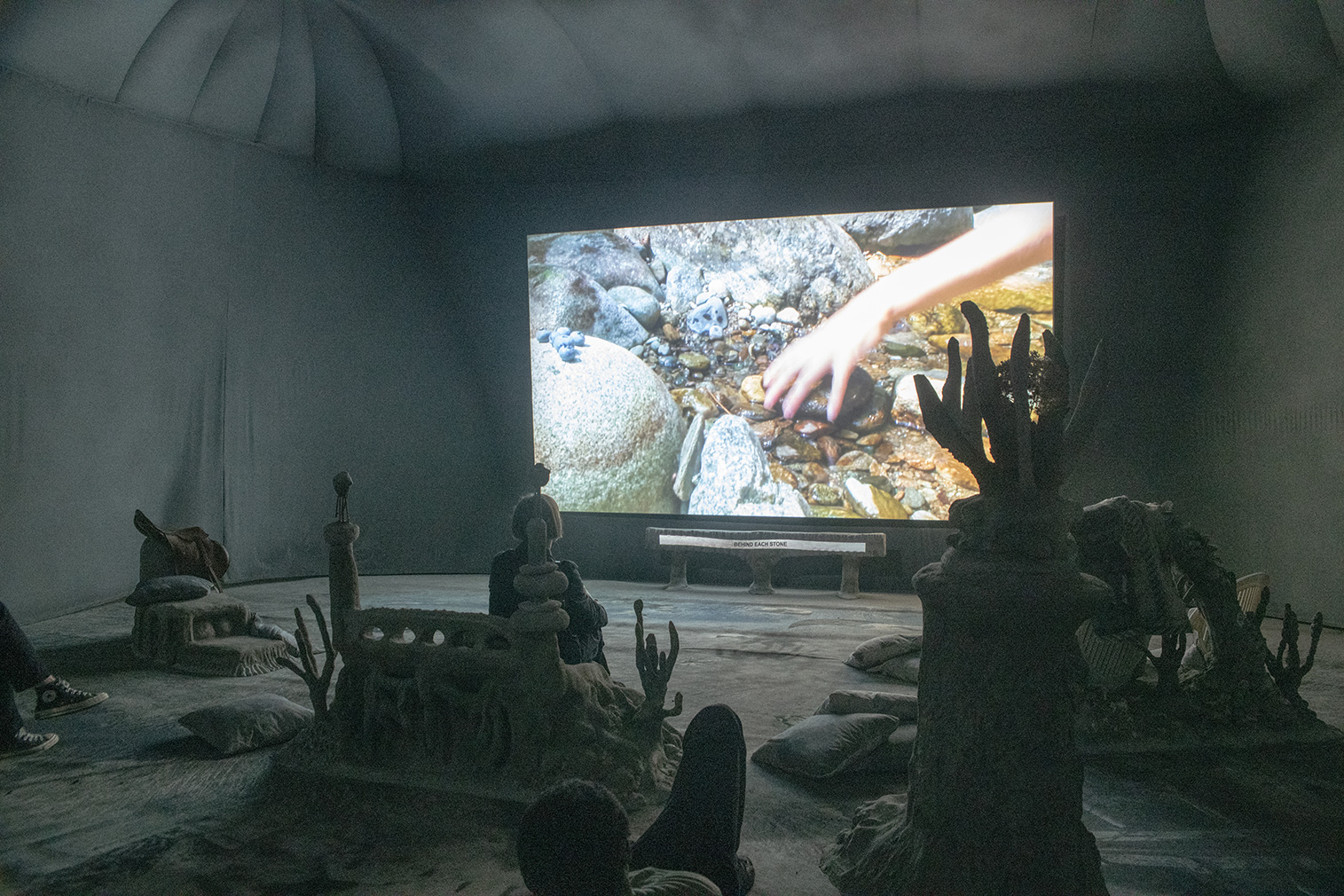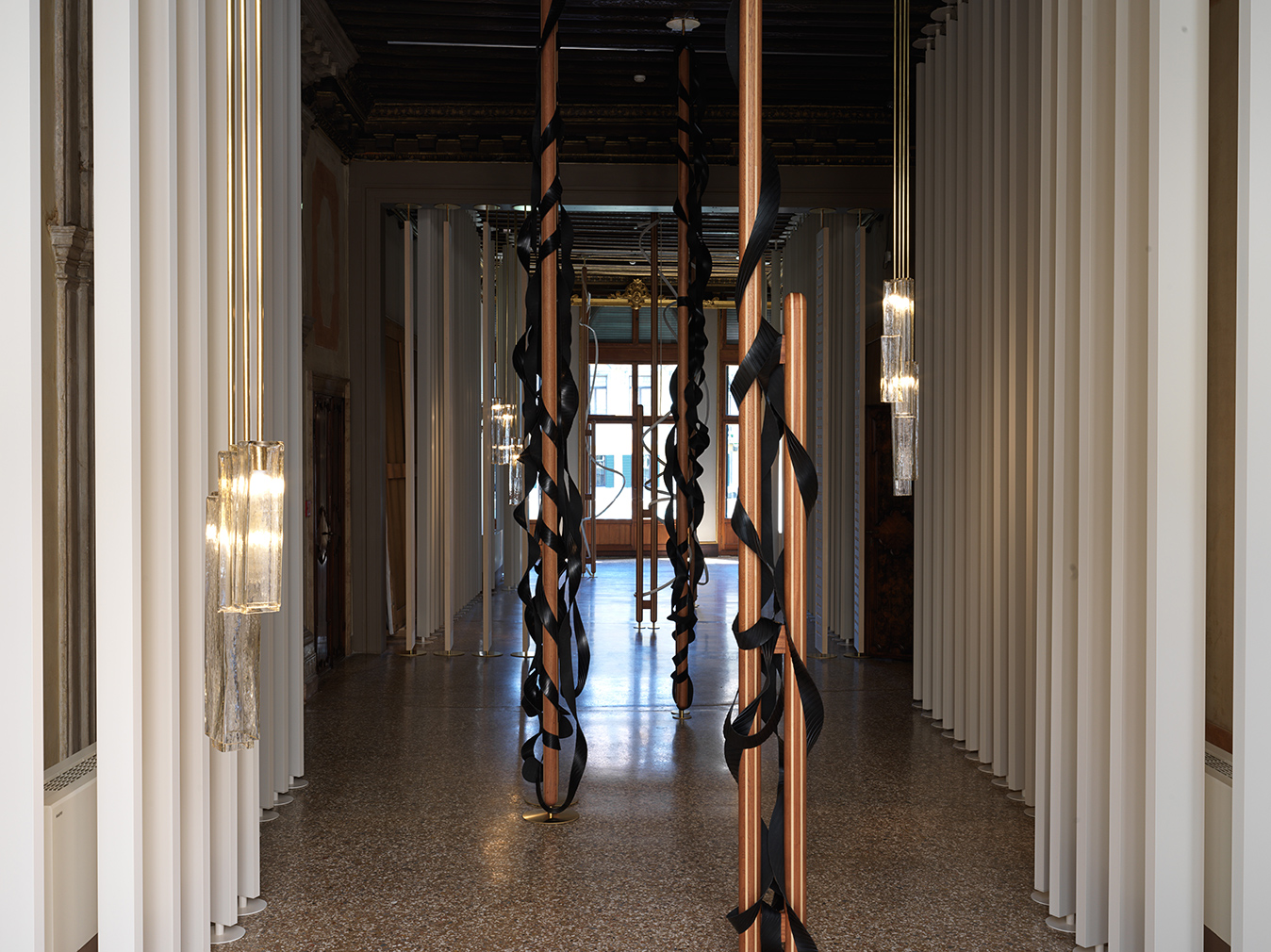A cold, artificial mist lingers above the roof of the chalky-white main building. It slowly winds its way over the sandy, rain-soaked paths of the Giardini, creeps beneath vinyl Balenciaga parkas and envelops the shrill and colorful summer dresses. Frozen gazes, hunched shoulders and crossed arms among the queuing crowd. We are facing uncertain times. Worse, in fact: We are right in the middle of them, immersed in fake news, climate disasters and social crises. “May you live in interesting times” is the title curator Ralph Rugoff has given this year’s Biennale.
In doing so, he refers to a saying that was passed off as a Chinese curse for many years. Sounds like confusion, like moral judgement, like finger-wagging. And yet that’s not what Rugoff is concerned with: Political instructions are not a task for art, he claims; rather, it should reveal multiple perspectives and question existing concepts.
So much for theory! But now to the practice: With every lamentation about all the “bad art” that can undoubtedly be seen at every Biennale, this year there is at least as much moving and stimulating work that even offers a positive outlook. And this definitely makes it worth the trip.
MAIN EXHIBITION
From each of the 79 exhibiting artists works are on display in both the Arsenale and the Giardini. Particularly noticeable this year are the numerous video and sound works. One that sticks in your memory is Haris Epaminonda’s “Chimera” (2019). In her 30-minute film, she combines found-footage shots with a soundscape by Kelly Jayne Jones and creates meditative images of abandoned places and landscapes, which hover somewhere between memory and conceptual construction. The work deservedly earned Epaminonda the Silver Lion.
Lawrence Abu Hamdan himself can be seen in his film “Walled Unwalled.” In arecording studio he talks about legal cases in which sound literally seeped through walls and thus provided evidence. In his so-called “lecture performances,” the human voice frequently functions as political material, which is used primarily by governments and big data companies. The film was recorded at the Funkhaus Studios, which was formerly used for broadcasting radio programs in the GDR.

Haris Epaminonda, Chimera, 2019, Image courtesy Ben Davis, Image via artnet.com

Lawrence Abu Hamdan, Walled Unwalled, 2018, Courtesy of the artist, Image via squarespace.com
The space-filling sound performance by Tarek Atoui at the Arsenale is an absolute must. In his collaborative projects, music and contemporary art merge and the perception of sound takes place on multiple levels at the same time: visually, acoustically and physically. Such is the case in “The GROUND” (2019), developed from the five years Atoui spent in China’s Pearl River Delta. He captured the cultural, architectural and musical practices of the region in a booklet, which he subsequently presented to artisans and musical instrument makers. You could spend hours listening to the sounds of the instruments Atoui arranged, following their rhythmically coordinated movements.

A popular highlight is Cyprien Gaillard’s “L’Ange du Foyer (Vierte Fassung)” (2019): a hologram of a dragon based on the template of Max Ernst’s work of the same title, which rises up as if possessed by the Devil, appearing to fight for its life. At least as many cell phones were trained on Ian Cheng’s “BOB (Bag of Beliefs)” (2018-19), an artificial intelligence creature that continually mutates like a red coral on a seabed, moving in a dance-like manner.
Of the paintings and photographs exhibited, the works by Zanele Muholi immediately lodge in the memory. The photographs stem from her archive of portraits of black, lesbian women in South Africa, which has been growing since 2006. Muholi is not only engaged as an artist, but also a co-founder of the “Forum for the Empowerment of Women” and “Inkanyiso,” a platform for queer activism. Njideka Akunyili Crosby’s large-format, richly storied images are also particularly striking. In her work she focuses primarily on her experiences as a member of the Nigerian diaspora and interweaves not only different materials and media to form a multilayered overall collage, but also creates links with visual artists and well-known African writers.


Pavilions
France
The biggest rush of the first few days was to the French Pavilion. Anyone wanting to see Laure Prouvost’s astonishing work there had to make a run for it. Or wait in line for at least two hours. Prouvost and a group of actors of varying generations traveled from the suburbs of Paris to the Venetian Lagoon, taking detours along the way. In the resulting film, “Deep See Blue Surrounding You,” images explode one after another: screeching cries from bright red mouths, rolling eyeballs and long, octopus-tentacles set to booming sounds alternate with scenes of a magician in a rural dive bar, windblown hair in a moving vehicle and childishly exuberant dances are set to a brass band.
Embedded in an overall installation of the film props, at the end you stagger, blinking, back outside in search of some orientation: Where are we coming from? Where are we going? The question asked in the film is thought-provoking. Etched in stone next to the exit you might find the answer: “Ideally you would go deeper to the back of this building.”

Laure Prouvost, Deep See Blue Surrounding You / Vois Ce Bleu Profond Te Fondre, 2019 © Giacomo Cosua, Image via thespaces.com

Canada
The video work by the collective “Isuma” in this year’s Canadian Pavilion represents the first indigenous contribution to the Venice Biennale. It was back in 2001 that the collective won the Golden Camera in Cannes for its film “Atanarjuat (The Fast Runner),” and the three video works exhibited at the Biennale are renewed testament to its impressive research efforts. In interviews, Inuit people talk about their resettlement and the painful loss of their previous lives.
Selected productions can be watched online on IsumaTV
Brazil
The film by artist duo Bárbara Wagner and Benjamin de Burca in the Brazilian Pavilion is at least as striking as the one by Laure Prouvost. The playful, life-affirming Swingueira dances appear in their film “Swinguerra”(!) as the most logical and most obvious of all strokes of liberation in a country full of political and social tension. Here transgender protagonists, women heavy and thin, Beyoncé doubles and testosterone-laden teenagers swing their hips to the music with so much pride and self-assurance that you rather wish you could join in. Art revealing political, cultural and social tensions without wagging a warning finger.


Lithuania
From the canvas back to reality, leaving the Giardini: In the somewhat outlying Lithuanian Pavilion, you suddenly find yourself at the beach. This brief sojourn at the Arsenale Marinare is not to be missed. As you wait in line, you are joyfully regaled with the opera performance “Sun & Sea (Marina)” by the outstanding artist trio of Rugilė Barzdžiukaitė, Vaiva Grainytė and Lina Lapelytė, while singing voices emanate from the building.
Inside, a bird’s-eye perspective opens up onto a Truman Show-like beach scenario: a mosaic of colorful towels, parasols, a yapping dog and, spread among them all, opera singers in bathing suits, who strike up songs of everyday woes and loss. The artificial sunlight, the heat lamps and the concrete walls enclosing it all are reminders that nothing is authentic here. And yet the whole scenario seems eerily real. It’s not for nothing that the Lithuanian Pavilion has been awarded the Golden Lion for this unique contribution.
Attention: Only until October 31, 2019
Portugal
An entirely different perspective is offered by the Portuguese Pavilion. Directly around the corner from the Accademia at the Palazzo Giustinian Lolin is “a seam, a surface, a hinge, or a knot” by Leonor Antunes. Her interest in everyday materials, substances and structures, particularly in the Venetian context, is expressed in abstract sculptures that interweave almost imperceptibly with the structure of the magnificent palazzo. Parts of the exhibition were produced with the Falegnameria Augusto Capovilla, one of the few joineries still active in Venice. Rhythmic forms made of noble woods, steel and glass lamps from Murano merge with the rooms of the palazzo to form an architectural Gesamtkunstwerk.


Leonor Antunes, a surface, a seam, a hinge, or a knot, 2019, Courtesy the artist and Air de Paris, Paris; Marian Goodman Gallery, New York, Paris & London; kurimanzutto, Mexico City & New York; Galeria Luisa Strina, São Paulo, Image via thespaces.com
Beyond the official program
Venice is small, but the Biennale is always too big. After three days of pushing and shoving, waiting in line, sprints to pavilions and overcrowded vaporetti, even the most seasoned of artistic marathon runners will run out of energy. Anyone who can manage it though, should take a look outside of the Giardini-Arsenale box once again and make a beeline for the these two places:
Ocean Space
In March, Ocean Space at the Chiesa di San Lorenzo opened its doors for the first time. Launched by the TBA21 Academy, it is dedicated to the myths of the sea, combining research, poetry and art. It was inaugurated with “Moving Off the Land II” by Joan Jonas. The 82-year-old artist visited aquariums worldwide, filming and researching the breadth of the oceans and thus producing an artwork combining film and performance, with sound, image and language flowing poetically into one another. Visitors to the Ocean Space can see the images and film sequences resulting from this, which – without appearing to preach in any way – present the sensuousness of the sea and the closeness of its inhabitants to human beings, as well as the tragic consequences of its contamination.
Until September 29, 2019



Palazzo Grimani
With “Pintura/Panorama,” Palazzo Grimani has dedicated a retrospective spanning 40 years to Helen Frankenthaler, who has long been overshadowed by artists like Jackson Pollock and Mark Rothko. Having grown up among the second generation of abstract expressionists in the USA, she used her soak-stain technique to create abstract forms from blocks of color flowing into one another on large-format canvases. This is the first time her works have been exhibited in Venice since 1966, when she was involved in the American Pavilion for the 33rd Biennale. It’s an exhibition that heightens the anticipation for Lee Krasner in the fall.
Until November 17, 2019

Helen Frankenthaler, Italian Beach, 1960, Image Courtesy of Gagosian and the Helen Frankenthaler Foundation, Image via myartguides.com